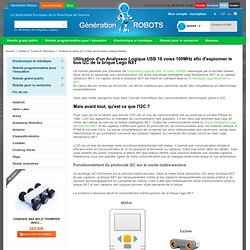

GENELAIX.
Matlab. Webinarconf. Controlling fan with a Arduino, a nunchuk, a DS touch screen and a PID. Controlling a fan with an Arduino, a nunchuk, a DS touch screen and a PID: I created a small application with an Arduino, which calculates and controls (with or without PID) the rotation speed of a fan from three items: 1- a Nintendo nunchuck 2- a Nintendo DS screen 3- a Temperature Sensor TMP36 A tilt sensor can switch off the fan if a vibration is detected, a red LED lights up and waits for user intervention. This application could for example be used to regulate the temperature inside a box. The fan speed is calculated by interruptions performed by the Arduino and generated through an optocoupler placed against the fan.
A PID Arduino library can control the rotation speed according to a setting point speed obtained using a correspondance between speed and temperature, vitesse_consigne = f (temperature). 2 - The Nunchuk mode is activated by pressing constantly on Z button, the X acceleration then vary the fan speed, for values ranging from speed 1 to 9 (same speeds as the DS screen). Mach.elec.free.fr/simulation/intro_auto_matlab.pdf. Analyse de trame I2C à l'aide de l'analyseur logique Saleae. Utilisation d'un Analyseur Logique USB 16 voies 100MHz afin d'espionner le bus I2C de la brique Lego NXT Ce tutoriel présente une utilisation de l'analyseur Logique USB 16 voies 100MHz développé par la société Saleae.

Nous allons ici espionner une communication I2C entre une brique intelligente Lego Mindstorms NXT et un capteur Ultrasons NXT. Ce capteur sonar à ultrasons NXT est fourni en standard dans le kit robotique Lego Mindstorms NXT. En raison de son niveau de technicité, cet article s’adresse aux personnes ayant des compétences en électronique essentiellement. Sans plus tarder plongeons nous dans l'univers merveilleux des communications électroniques grâce à l'I2C. Mais avant tout, qu'est ce que l'I2C ? Pour ceux qui ne le savent pas encore, l'I2C est un bus de communication mis au point par la société Philips en 1982. L’I2C est un bus de données série synchrone bidirectionnel half-duplex. Fonctionnement du protocole I2C sur le mode maître-esclave Conclusion. Balancing robot for dummies. [size=14] ** Balancing robot for dummies **[/size] [size=14]Part two: sensors aquisition smoothing and zeroing, angle calculation[/size] Forewords: Acc sensors are... noisy :o [size=14]1 - Accelerators response vs gravity[/size] taken from the ADXL330 data sheet [size=14]2 - Zeroing sensor[/size]Before aquiring data in the loop, sensors should be zeroedThis means that when the bot is stricly still and vertical, sensors should read "0"except for the vertical axis (Acc_Z), which is sensing gravity (1g) Zero mesurement is performed in setup: void calibrateSensors() { // Set zero sensor values long v; for(int n=0; n<3; n++) { v = 0; for(int i=0; i<50; i++) v += readSensor(n); sensorZero[n] = v/50; } sensorZero[ACC_Z] -= 102; }
